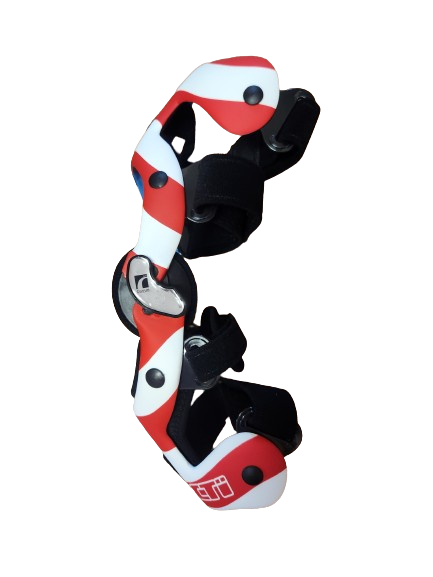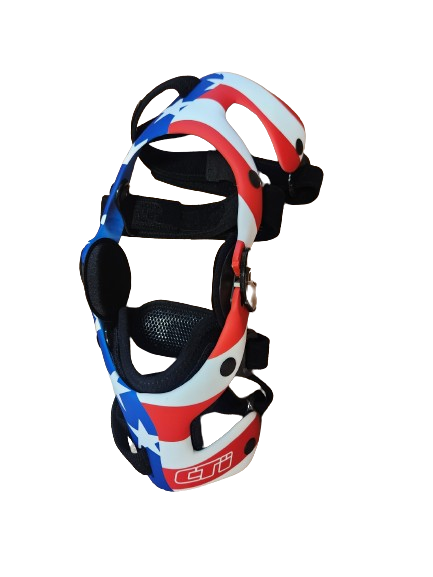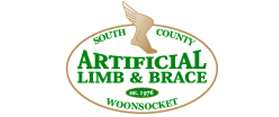Knee Orthoses & Knee Ankle Foot Orthoses (KAFO's)
Knee Orthoses (KOs) and Knee Ankle Foot Orthoses (KAFOs) are types of orthopedic braces used to support, align, prevent, or correct deformities, or to improve the function of a body part.
Knee Orthoses (KOs):
- Purpose: Knee Orthoses are braces that are specifically designed to support the knee joint. They are often used to stabilize the knee after an injury, to prevent injury, or to manage chronic conditions like arthritis.
- Design: A typical KO wraps around the knee and may extend above or below the joint to provide additional stability. They can vary in rigidity, from soft sleeves to rigid braces with metal supports.
- Use Cases:
- Post-injury support: After ligament injuries (e.g., ACL tears).
- Preventive: For athletes to prevent injuries.
- Chronic conditions: To manage pain or instability in conditions like osteoarthritis.
Knee Ankle Foot Orthoses (KAFOs):
- Purpose: KAFOs are braces that extend from the thigh to the foot, encompassing the knee, ankle, and foot. They are designed to support the entire leg and are typically used for more significant or complex conditions affecting multiple joints.
- Design: KAFOs consist of a knee orthosis integrated with an ankle-foot orthosis. They usually include metal or plastic uprights that run along the leg, with cuffs or straps that secure the brace at the thigh, knee, ankle, and foot.
- Use Cases:
- Neurological conditions: For patients with spinal cord injuries, polio, cerebral palsy, or muscular dystrophy.
- Orthopedic conditions: To support legs weakened by fractures, deformities, or degenerative diseases.
- Post-surgical recovery: To immobilize and support the leg after major surgery.
Both KOs and KAFOs are custom-made or fitted by orthopedic specialists to ensure proper support and comfort.
Knee Ankle Foot Orthoses (KAFOs)
Click to Expand
Custom Knee Ankle Foot Orthoses (KAFO's) can be crafted in our workshop in Wakefield, Rhode Island, or they may be sent to a trusted orthopedic supply company such as Ossur.
To get started we will need a prescription from your doctor complete with diagnostic codes. Once we've clearly communicated with your doctor on how to best assist you, a plaster cast will be taken of your leg which will be used to fabricate an orthosis designed just for you.
Once your device is ready, and meets our high standards, you will be instructed on how to don and properly care for your new KAFO and a follow-up appointment may be scheduled. Over time, your device will require maintenance such as having new straps or pads installed. We will always be a phone call away for any questions or concerns about your device.

Knee Orthoses (KOs)
Click to Expand
Getting a knee brace involves several steps to ensure that you receive the appropriate support and fit for your specific needs. Here’s an overview of the typical process:
1. Initial Consultation
- Meet with a Healthcare Professional: Start by consulting with your doctor. They will assess your knee condition, discuss your symptoms, and determine if a knee brace is necessary.
2. Prescription and Referral
- Prescription: If a knee brace is deemed necessary, your healthcare provider may write a prescription with diagnostic codes.
- Referral to an Orthotist (This is where we come in!): Your doctor may refer you to us by faxing us a prescription with diagnostic codes, notes from your last office visit, and your demographics. We are trained orthotists, specialists in designing and fitting orthopedic braces.
3. Evaluation and Measurements
- Orthotist Evaluation/Measurements: Precise measurements of your knee and leg will be taken to ensure the brace fits correctly. In some cases, a mold of your knee may be made for custom braces.
4. Fitting/Delivery and Adjustments
- Delivery Appointment: Once the brace is ready, you’ll have an initial fitting session. The orthotist will ensure the brace fits properly, is comfortable, and provides the necessary support.
- Adjustments: Any necessary adjustments will be made to optimize the fit and function of the brace.
5. Education and Training
- Usage Instructions: The orthotist will teach you how to properly wear, adjust, and care for the brace.
- Practice: You’ll practice putting the brace on and taking it off, as well as learning how to use it during different activities (e.g., walking, sports).
6. Follow-Up Appointments
- Follow-Up Appointments: Follow-up appointments may be scheduled to monitor your progress, make further adjustments, and ensure the brace is working effectively.
- Long-Term Care: If your condition changes or if the brace wears out, you may need additional evaluations and adjustments over time. Please do not hesitate to call us if you have any questions or concerns about your device!


Custom Orthotronic Mobility System
The Orthotronic C Brace is a Knee Ankle Foot Orthosis (KAFO) that features a robotic knee joint.
We were the first to offer the Orthotronic Brace in Rhode Island and New England.
We have fitted more patients with the Orthotronic C Brace than any other facility in the country.
Our expertise with this advanced technology surpasses that of any other orthotic facility nationwide!

